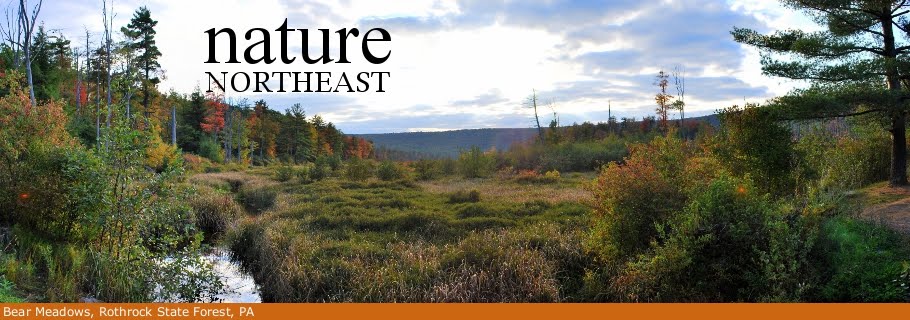For centuries, witch hazel (Hamamelis virginiana) has been valued for its medicinal properties, but this quirky plant is also well-known for some of its unusual traits.
 |
| Witch hazel (Hamamelis virginiana) |
Witch hazel occurs throughout the northeastern United States and ranges west to Minnesota and south to Texas and Florida. It is shade tolerant and it is encountered most frequently in moist, rich woods or along stream banks- though it can be found growing on drier sites.
Witch hazel can grow to be a large shrub or smallish tree reaching 16 feet (5 meters). A single individual generally consists of multiple contorted stems ascending from a shared root system.
The leaves, which measure from 2 to 6 inches (5-15 cm), are alternately arranged on the stems and are roughly oval-shaped. The leaves have pointed tips and rounded teeth along their wavy margins. The bases of the leaves are also inequilateral, meaning that the leaves are not symmetrical where the petiole meets the leaf blade.
Unlike most woody species, the leaf buds of witch hazel are 'naked.' They lack 'bud scales' which are produced by other plants to protect tender new leaves before they unfurl.
Witch hazel also has the designation of being the only woody plant species in the northeast to bloom in autumn. While most plants are going dormant in October and November, witch hazel bursts into full flower even as it sheds its own leaves.
The flowers are a peculiar sight. Each flower has 4 linear petals that radiate from the center. The yellow petals, which measure about 3/4 inch (2cm), appear to me like miniature crepe streamers. Although the surface area of a single flower may not be large, the flowers generally occur in dense clusters and produce a tangled mass of petals that is very noticeable from afar.
The flowers last a considerably long time. Individual flowers may remain for several weeks which increases their chances of being pollinated by insects like gnats, flies, and wasps on the occasional balmy autumn day. Despite being pollinated in the autumn, the flower's ovules won't be fertilized until the spring when the pollen grains finally germinate. As if this wasn't enough of a delay, the fruits will not mature until the following autumn when the next set of flowers are in bloom.
Witch hazel produces woody capsules. As they dry, the tops of the capsules begin to open while the bases contract. This shrinking of the base puts pressure on the seeds. Eventually, enough pressure builds up to project the seeds out of the capsule and into the air. Henry David Thoreau observed this and recorded it in his journal: "Heard in the night a snapping sound, and the fall of some small body on the floor from time to time. In the morning I found it was produced by the witch-hazel nuts on my desk springing open and casting their seeds quite across my chamber, hard and stony as these nuts were." Some sources claim that the seeds can be shot up to 30 feet away.
Witch hazel produces woody capsules. As they dry, the tops of the capsules begin to open while the bases contract. This shrinking of the base puts pressure on the seeds. Eventually, enough pressure builds up to project the seeds out of the capsule and into the air. Henry David Thoreau observed this and recorded it in his journal: "Heard in the night a snapping sound, and the fall of some small body on the floor from time to time. In the morning I found it was produced by the witch-hazel nuts on my desk springing open and casting their seeds quite across my chamber, hard and stony as these nuts were." Some sources claim that the seeds can be shot up to 30 feet away.
Witch hazel is an interesting plant to behold, especially given some of its unusual traits, but this native shrub is probably best known for its medicinal uses.
Witch hazel has long been valued for its astringent properties. It is said that Native Americans would use poultices or liniments made from the leaves, twigs, and inner bark as a treatment for sore muscles, cuts, insect bites, and inflammation.
In 1866, a Baptist clergyman by the name of Thomas Newton Dickinson established the first witch hazel distillery in the town of Essex, CT. He continued to add another 8 production facilities throughout eastern Connecticut during his lifetime, but upon his death in 1900, the company was split between his sons and operated as two separate entities. In 1997, the two branches of Dickinson's original enterprise finally rejoined to form Dickinson's Brands which is still in business.
Today, extracts from witch hazel are used as a natural treatment for problems such as varicose veins and hemorrhoids and as a constituent of skin care and aftershave products.
Witch hazel has long been valued for its astringent properties. It is said that Native Americans would use poultices or liniments made from the leaves, twigs, and inner bark as a treatment for sore muscles, cuts, insect bites, and inflammation.
In 1866, a Baptist clergyman by the name of Thomas Newton Dickinson established the first witch hazel distillery in the town of Essex, CT. He continued to add another 8 production facilities throughout eastern Connecticut during his lifetime, but upon his death in 1900, the company was split between his sons and operated as two separate entities. In 1997, the two branches of Dickinson's original enterprise finally rejoined to form Dickinson's Brands which is still in business.
Today, extracts from witch hazel are used as a natural treatment for problems such as varicose veins and hemorrhoids and as a constituent of skin care and aftershave products.
